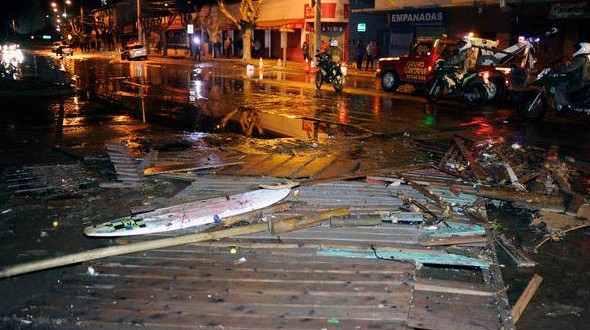Chile – A powerful magnitude-8.3 earthquake hit off Chile’s northern coast Wednesday night, causing buildings to sway in Santiago and bringing flooding from small tsunami waves in some shore towns.
Earthquakes are caused when a stuck portion of a fault overcomes friction and abruptly releases. While we talk abut the epicenter where the earthquake starts, in reality an entire area ruptures and slides. Larger ruptures produce larger magnitude earthquakes: this one was the result of a slip area roughy 230 kilometers long by 100 kilometers wide slipping a few meters.
The earthquake was at a depth of 12.3 kilometers, which is relatively shallow for a large event like this. That means that the shaking was focused to be more intense over a smaller area than it would have been with a deeper earthquake. This earthquake shows the characteristics of a thrust earthquake, directly releasing stress along the primary boundary between the plates.
https://www.youtube.com/watch?v=U7N3FkkNeMc
Severe shaking lasted approximately 80 seconds, with milder surface shaking continuing for 190 seconds from start to end.
Earthquake magnitudes are notoriously difficult to get right quickly. The earthquake was listed as a moment magnitude 7.9 when I started drafting this article, and upgraded to an 8.3 before I published! Notice that’s a different scale than Richter: moment magnitude more accurately reflects the true energy released by larger earthquakes. Earthquakes of this scale happen roughly once a year.
The earthquake’s epicenter was just 46 kilometers (29 miles) west of Illapel, Chile, a city with a population of roughly 23,000 people. The earthquake was about 228 kilometers (142 miles) north-northwest of Santiago, Chile’s capital and largest city: that’s close enough that buildings swayed in the earthquake.
Although local geology can emphasize or dissipate shaking, the current estimate is that around 54,000 people were exposed to very strong shaking, with close to ten million people exposed to moderate to strong shaking. Another one to two million people likely felt light shaking.
One woman is reported dead in Illapel, crushed by a falling wall. Another four died from yet-undisclosed injuries. At least 20 others are injured.
Tsunami warning extended to entire east coast
Scientists say a major tsunami is not expected to strike the state of Hawaii.
However, sea level changes and strong currents may occur along all coasts that could be a hazard to swimmers and boaters as well as those near the shore at beaches and in harbors and marinas. The threat may continue for several hours after the initial wave arrival.
The estimated earliest arrival of the initial wave is at 3:11 a.m. Thursday.
Hawaii could see waves reaching 0.3 to 1 meter above the tide level.
Agencies/Canadajournal
 Canada Journal – News of the World Articles and videos to bring you the biggest Canadian news stories from across the country every day
Canada Journal – News of the World Articles and videos to bring you the biggest Canadian news stories from across the country every day



